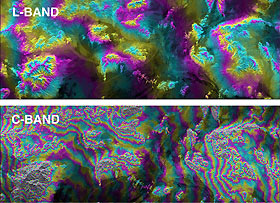
Save this image free of charge
in 800 pixels for layout use
(right click, Save as...)
|
|
Ref : V01770
Theme :
Looking at Earth - Cities (375 images)
Title : Space Radar Image of Fort Irwin, California
Caption :
This image of Fort Irwin in California's Mojave Desert compares interferometric radar signatures topography -- data that were obtained by multiple imaging of the same region to produce three-dimensional elevation maps -- as it was obtained on October 7-8, 1994 by the Spaceborne Imaging Radar-C/X-band Synthetic Aperture Radar aboard the space shuttle Endeavour. Data were acquired using the L-band (24 centimeter wavelength) and C-band (6 centimeter wavelength). The image covers an area about 25 kilometers by 70 kilometers (15.5 miles by 43 miles). North is to the lower right of the image. The color contours shown are proportional to the topographic elevation. With a wavelength one-fourth that of the L-band, the results from the C-band cycle through the color contours four times faster for a given elevation change. Detailed comparisions of these multiple frequency data over different terrain types will provide insights in the future into wavelength- dependent effects of penetration and scattering on the topography measurement accuracy. Fort Irwin is an ideal site for such detailed digital elevation model comparisions because a number of high precision digital models of the area already exist from conventional measurements as well as from airborne interferometric SAR data.Spaceborne Imaging Radar-C and X-band Synthetic Aperture Radar (SIR-C/X- SAR) is part of NASA's Mission to Planet Earth. The radars illuminate Earth with microwaves, allowing detailed observations at any time, regardless of weather or sunlight conditions. SIR-C/X-SAR uses three microwave wavelengths: L-band (24 cm), C-band (6 cm) and X-band (3 cm). The multi-frequency data will be used by the international scientific community to better understand the global environment and how it is changing. The SIR-C/X-SAR data, complemented by aircraft and ground studies, will give scientists clearer insights into those environmental changes which are caused by nature and those changes which are induced by human activity.SIR-C was developed by NASA's Jet Propulsion Laboratory. X-SAR was developed by the Dornier and Alenia Spazio companies for the German space agency, Deutsche Agentur fuer Raumfahrtangelegenheiten (DARA), and the Italian space agency, Agenzia Spaziale Italiana (ASI), with the Deutsche Forschungsanstalt fuer Luft und Raumfahrt e.V.(DLR), the major partner in science, operations and data processing of X-SAR.
|
|

